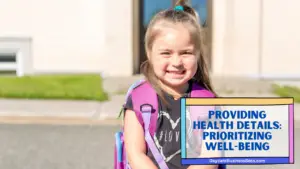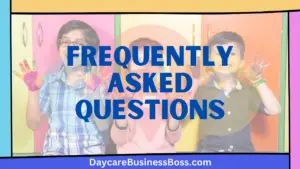The road of motherhood is extraordinary, filled with endless love, cherished memories, and the desire to provide the best for our children. Among the several milestones on this journey, putting your child in the care of daycare is a huge shift. As parents, ensuring that this transition is easy, secure, and emotionally fulfilling becomes a key priority. This is when a nice childcare checklist for leaving a child off at daycare comes into play.
The most useful approach when dropping a child at daycare involves clear communication about routines, offering comfort items, sharing emergency contacts, and providing health details. These steps ensure a smooth and secure transition for the child’s daycare experience.
The article will dig into the checklist’s essential components. Let us embark on this adventure of discovery as we find the key to making daycare drop-offs a memorable step toward growth and development.
Clear Communication: Establishing Routine Confidence

Communication is the foundation of any endeavor, and this principle is especially important when commencing on the road of introducing your child to daycare. Before that critical first day, having truthful and open conversations with the daycare workers is critical. You are providing caregivers with crucial information by sharing specific details about your child’s daily habits, including meal timings, nap patterns, and favored activities. This wealth of knowledge enables them to easily integrate their child into the intricate tapestry of the daycare’s established rhythm. A shift that is not just smoother, but also less disruptive and stressful.
However, communication is more than just conveying everyday routines. It covers a broader range of issues, such as addressing any worries or any unique needs your child may have. The declaration of allergies, dietary restrictions, and other special needs is a critical step in ensuring your child’s best well-being. This proactive approach not only emphasizes your dedication as a parent but also serves as a solid pillar for developing trust between you and the caregivers. This trust, in turn, creates an environment in which your child’s emotional and psychological well-being is prioritized during their time at the daycare.
You’re effectively creating a roadmap for your child’s flawless absorption into this new chapter through the art of communication. A chapter in which caregivers have a holistic awareness of their child’s needs, preferences, and quirks, rather than just an academic understanding. This increased awareness elevates the daycare from a place of surveillance to one of growth and development, supported by the customized attention and understanding your kid deserves.
Read more about: Day Care Done Right: Embracing the Power of the Development Checklist
Comfort Items: A Sense of Familiarity
A child may feel overwhelmed upon entering the strange world of daycare. The overwhelming unfamiliarity of new faces, surroundings, and habits can easily cause discomfort and anxiety. However, there is a simple yet effective option that might reduce these sensations and make the adjustment easier: bring comfortable objects from home.
The importance of these comfort items cannot be emphasized during this delicate period of adjustment. A treasured blanket with the aroma of home, a favorite stuffed animal that emanates warmth, or even an item of clothing imbued with the atmosphere of home can all serve as valuable lifelines amidst the sea of newness. These artifacts have the magical potential to transform the unknown into the known, providing a reassuring touchpoint that speaks of continuity and security.
These home-infused comfort items serve as emotional anchors for the child. In the middle of a whirlwind of new experiences, these relics of comfort whisper stories of reassurance, reminding the youngster that no matter how diverse their surroundings may be, a piece of their sanctuary is always with them. This emotional crutch not only relieves anxiety but also promotes gradual adaption to the daycare setting.
Beyond the child’s emotional comfort, adding these items creates an important link between the worlds of home and daycare. This seemingly ethereal bond has enormous potential in relieving the pangs of separation anxiety and loneliness that can often accompany a child’s first childcare experiences. The presence of a familiar object from home serves as a visible reminder that the two domains are linked and that the love and security of home can also extend to this new environment.
These comfort objects go much beyond their physical appearance. They are emotional bearers, consolation bearers, and resilience builders. They support the child’s trip into the unknown by assuring they are not alone. As the youngster clings to the warmth of their prized blanket or seeks camaraderie in their favorite toy, they are building a connection to their new surroundings. This bond serves as a guiding thread, gently guiding people through the complex labyrinth of change.
Sharing Emergency Contacts: Preparedness and Peace of Mind
Unexpected circumstances can quickly develop in life, especially when it comes to the well-being of children in a daycare setting. Given this reality, keeping an up-to-date and thorough list of emergency contacts is a critical obligation for parents. This list, which includes not only parents and guardians, but also extended family members and even neighbors, acts as a lifeline, ensuring quick contact and action during key periods.
Sharing such a comprehensive list of contacts is more than a simple administrative requirement; it reflects a profound commitment to good parenting. By committing this critical information to the daycare staff, parents are essentially expanding their circle of trust, acknowledging the caregivers as participants in the child’s safety journey. This proactive gesture is consistent with the idea that safety is a team effort that necessitates the coordination of parental and caregiver attentiveness.
A well-prepared emergency list should include essential medical information in addition to contact information. Allergies, pre-existing medical problems, and prescribed medications may seem insignificant on a routine basis, but in the event of an emergency, they can be life-saving. Caregivers’ ability to make educated judgments and deliver appropriate care grows enormously when they have this critical medical knowledge. The availability of such knowledge in a time of crisis can be a game changer, in determining the result and aftermath of the incident.
The collaboration of parents and caregivers in maintaining an accurate and up-to-date emergency contact list creates a sense of security in the childcare setting. This joint dedication to the child’s well-being produces a protective cocoon that can alleviate parental concerns and provide caregivers with the resources they need to respond quickly.
This approach represents the notion of readiness, a quality that extends beyond the confines of daycare life and translates to key life skills. By communicating emergency information in advance, parents teach their children responsibility and forethought, fostering a culture of preparedness that extends beyond the immediate daycare context.
Providing Health Details: Prioritizing Well-Being

Prioritizing your child’s health and overall well-being is an important part of their daycare experience. In the thrill of new experiences and connections, it is critical to lay a solid foundation of health-related communication with caregivers. This technique, based on the open sharing of full health information, holds the key to creating a safe and caring atmosphere that meets your child’s specific requirements.
The idea that each kid is unique, with distinctive health needs that must be acknowledged and handled, is at the center of this practice. The ability of caregivers to perform this role effectively is dependent on clear and thorough communication of health-related information. Allergies, dietary restrictions, previous medical history, and ongoing treatments – this seemingly trivial information can have a huge impact on avoiding serious health concerns.
Parents empower childcare employees to make informed decisions regarding meals and snacks by revealing allergies and dietary restrictions. As a result, your child’s nutritional needs are satisfied while any potential allergens are avoided. Similarly, providing medical history and ongoing therapies helps caregivers gain a comprehensive picture of their child’s health landscape, allowing them to provide consistent and appropriate care.
The consequences of this open attitude go beyond physical wellness. Parents facilitate a personalized approach to activities and environments by openly discussing health details. This proactive stance emphasizes the importance of each child’s well-being, whether it’s picking appropriate sports and exercises or ensuring the proper safety precautions are in place. When children see that their health needs are being met, they gain a sense of importance and connection to the daycare setting. This strong emotional connection not only increases their comfort and confidence but also builds the framework for a joyful daycare experience.
Transparency in health communication is a team effort. It entails parents handing crucial information to caretakers and caregivers diligently incorporating this knowledge into the child’s daily routines. This collaboration creates an environment in which children feel seen, respected, and understood. The daycare setting, therefore, transforms into a safe refuge for children to play, learn, and grow, knowing that their health needs are not just acknowledged but championed.
Read more about: Opening a Special Needs Daycare Center: Providing Essential Care and Support
Smooth Farewell Routine: Building Emotional Resilience
Navigating the departure moment during your child’s daycare experience is more than a practical consideration; it’s a critical juncture that can have a significant impact on their emotional well-being. Making a smooth and reassuring farewell ritual as a parent is a strategic technique that can set the tone for your child’s day and add to their overall sense of security and comfort.
The cornerstone of this exit strategy is consistency. Establishing a quick but meaningful farewell ritual helps develop a predictable pattern that communicates to your child that you are there, attentive, and supporting. The idea is to find a happy medium: a schedule that respects your departure without generating undue stress. This pattern forms an important component of the child’s daycare experience, grounding them in a world that could otherwise appear foreign.
Incorporating aspects that bring both bodily and mental comfort is one excellent method to create this regimen. Begin with a soft hug to express your love and presence. Follow it up with a few soothing words assuring your child of your return and the exciting activities at daycare. This combination of touch and verbal assurance provides a holistic approach, addressing both the child’s emotional and understanding needs.
Parents can help their children develop emotional resilience by frequently adopting this leaving ritual. It demonstrates that separation is just temporary and that even when physically separated, the emotional bond remains strong. This understanding establishes a foundation of security and trust that extends beyond the childcare setting, influencing how the kid handles future separations and problems in life.
The long-term advantages of such a practice are significant. The ritual gradually becomes a dependable and soothing aspect of the child’s childcare routine. It converts the goodbye moment into a tolerable and familiar transition, replacing worry with anticipation. Separation anxiety, which is a common stumbling block in early childhood experiences, diminishes when the kid internalizes the message that departures are followed by joyous reunions.
Frequently Asked Questions

Why is it crucial to have clear communication about routines when dropping a child off at daycare?
Clear communication regarding routines assists daycare workers in integrating your child into their daily plan. Sharing meal times, nap schedules, and preferences helps to reduce interruptions and gives your child a sense of regularity and security in their new environment.
How might comfort products help my child move to daycare?
In the unfamiliar daycare setting, comfort objects from home, such as a beloved toy or blanket, provide a familiar touchpoint. These products provide emotional reassurance, ease anxiety, and eventually assist your child in adjusting to their new surroundings, so bridging the gap between home and daycare.
What information should I include in the emergency contacts and health information I provide to daycare staff?
Emergency contacts should include parents, guardians, relatives, and neighbors to allow for quick communication in the event of an emergency. Share your kid’s allergies, medical history, prescribed medications, and any special health needs with the daycare staff so that they can provide specialized care and establish a safe environment for your child.
To learn more on how to start your own daycare checkout my startup documents here.
The information provided by DaycareBusinessBoss.com (“The Site”) is for general informational purposes only. All information on the Site is provided in good faith, however, we make no representation or warranty of any kind, express or implied, regarding the accuracy, adequacy, validity, reliability, availability or completeness of any information on the Site. Under no circumstance shall we have any liability to you for any loss or damage of any kind incurred as a result of the use of the Site or Reliance on any information provided on the Site. Your use of the Site and your reliance on any information on the Site is solely at your own risk.
This blog post is for educational purposes only and does not constitute legal advice. Please consult a legal expert to address your specific needs. Terms and Conditions. (https://daycarebusinessboss.com/terms-conditions/)

Meet Shawn Chun: Entrepreneur and Childcare Business Fan.
I’m a happy individual who happens to be an entrepreneur. I have owned several types of businesses in my life from a coffee shop to an import and export business to an online review business plus a few more and now I create online daycare business resources for those interested in starting new ventures. It’s demanding work but I love it. I do it for those passionate about their business and their goals. That’s why when I meet a childcare business owner, I see myself. I know how hard the struggle is to retain clients, find good employees and keep the business growing all while trying to stay competitive.
That’s why I created Daycare Business Boss: I want to help childcare business owners like you build a thriving business that brings you endless joy and supports your ideal lifestyle.


